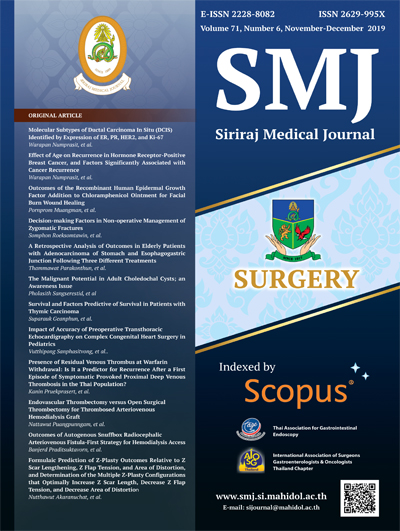The Malignant Potential in Adult Choledochal Cysts; an Awareness Issue
DOI:
https://doi.org/10.33192/Smj.2019.69Keywords:
Cholangiocarcinoma; choledochal cyst; malignancy; prognosis factors; risk factorsAbstract
Objective: Although still uncommon, choledochal cysts (CCs) are more frequently found in Asians than Caucasians. The incidence of malignancy associated with these cysts and the surgical outcomes have not been reported in Thailand.
Methods: A retrospective review was performed of 48 adult CC patients who underwent surgery January 2005–December 2015. Their clinical data and outcomes were analyzed.
Results: There were 31 (64.6%) female patients, with a female-to-male ratio of 1.8:1. The mean age + SD at diagnosis was 40.5 + 17.4 years. Using the modified Todani classification, 32 patients (66.7%) had a type I CC, one (2.1%) had type II, twelve (25.0%) had type IV, and three (6.3%) had type V. Twelve patients (25%) had a malignant tumor: eleven had synchronous cancer at surgery, while one with CC type I developed metachronous intrahepatic cholangiocarcinoma during the follow-up. The cholangiocarcinoma was inside the CC in 6 cases, intrahepatic in three, perihilar in two, and distal in one. The 5-year overall survival of the cohort was 68%. The factor affecting the overall survival was the coexisting cancer (p < 0.001). The 1-year and 5-year overall survival rates were 58.3% and 20%, respectively, for patients with cancer, but 96.7% and 88.4% for patients without cancer.
Conclusion: The adult choledochal cysts had a high incidence of associated malignancy. Factors predicting coexisting malignancy were an age above 40 years and a significant weight loss. If cancer occurred, the overall survival was significantly poor. Even after definitive surgery, patients still need life-long surveillance for cancer.
Downloads
Published
How to Cite
Issue
Section
License
Users are free to share, copy, and redistribute all articles published in the Siriraj Medical Journal (SMJ) in any medium or format as long as you follow the following terms:
- Attribution — You must give appropriate credit, provide a link to the material, and indicate if changes were made. You may do so in any reasonable manner, but not in any way that suggests the publisher endorses you or your use.
- NonCommercial — You may not use the material for commercial purposes.
- NoDerivatives — If you remix, transform, or build upon the material, you may not distribute the modified material.
- No additional restrictions — You may not apply legal terms or technological measures that legally restrict others from doing anything the license permits.











